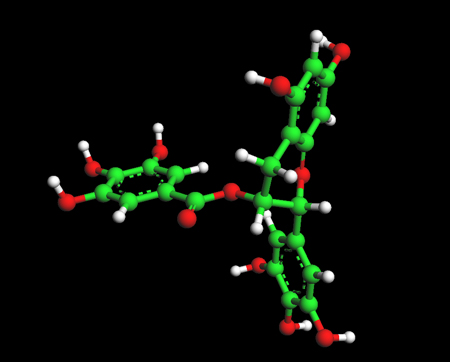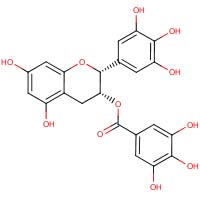Science and Health Benefits of Epigallocatechin gallate

Epigallocatechin gallate (EGCG), also known as epigallocatechin 3-gallate, is the ester of epigallocatechin and gallic acid, and is a type of catechin.
Molecular formula C22H18O11
Molar mass 458.37 g mol-1
Food Sources: Carob flour is the best source of epigallocatechin gallate but nuts, fruits and green tea are also very good sources. The dominant and most important catechin in green tea is (-) Epigallocatechin Gallate.

Epigallocatechin gallate (EGCG), also known as epigallocatechin 3-gallate, is the ester of epigallocatechin and gallic acid, and is a type of catechin.
EGCG is the most abundant catechin in tea and is a potent antioxidant that may have therapeutic applications in the treatment of many disorders (e.g. cancer). It is found in green - but not black - tea, as EGCG is converted into thearubigins in black teas. In a high temperature environment, an epimerization change is more likely to occur; however as exposure to boiling water for 30 straight minutes only leads to a 12.4% reduction in the total amount of EGCG, the amount lost in a brief exposure is insignificant. In fact, even when special conditions were used to create temperatures well over that of boiling water, the amount lost scaled up only slightly.[3]
EGCG can be found in many supplements.
EGCG and HIV
There has been research investigating the benefit of EGCG from green tea in the treatment of HIV infection, where EGCG has been shown to reduce plaques related to AIDS-related dementia in the laboratory, as well as block gp120.[4][5][6] However, these effects have yet to be confirmed in live human trials, and it does not imply that green tea will cure or block HIV infection, but it may help regulate viral load as long as it is not involved in adverse drug reactions. The concentrations of EGCG used in the studies could not be reached by drinking green tea. More study into EGCG and HIV is currently underway.[7]
EGCG and Cancer
There is increasing evidence to show that EGCG along with other flavonoids can be beneficial in treating brain,[8] prostate,[9][10] cervical[11] and bladder[12] cancers. EGCG has been shown to bind and inhibit the anti-apoptotic protein Bcl-xl,[13] which has been implicated in both cancer cell and normal cell survival.[14]
EGCG and endometriosis
Xu et al. found that antiangiogenic effects of EGCG inhibits the growth of blood vessels and thus reduces lesion size in experimental endometriosis (mouse model).[16]
Drug Interactions
A recent study using mouse models at the University of Southern California showed that, in contrast to the myriad benefits commonly associated with green tea and green tea extract (GTE), EGCG binds with the anti-cancer drug Velcade, significantly reducing its bioavailability and thereby rendering it therapeutically useless.[17] Dr. Schönthal, who headed the study, suggests that consumption of green tea and GTE products be strongly contraindicated for patients undergoing treatment for multiple myeloma and mantle cell lymphoma.[17] EGCG has a slight stimulatory effect due to it increasing adrenaline levels.[18][unreliable source?]Epigallocatechin-3-gallate, may reduce the bioavaialbilty of the drug sunitinib when they are taken together.[19]
Possible carcinogenic potential
EGCG was, among other tea polyphenols, found to be a strong topoisomerase inhibitor, similar to some chemotherapeutic anticancer drugs, for example, etoposide and doxorubicin. [20] [21] [22] [23][24] This property may be responsible for anticarcinogenic however also a carcinogenic potential of the substance. High intake of polyphenolic compounds during pregnancy is suspected to increase risk of neonatal leukemia. Bioflavonoid supplements should not be used by pregnant women.[25][26][27] A strong association between high intake of tea during pregnancy and elevated risk of childhood malignant central nervous system (CNS) tumours was found.[28]
References
- http://chemicalland21.com/lifescience/-EPIGALLOCATECHINGALLATE.htm
- http://www.caymanchem.com/pdfs/70935.pdf
- . doi:10.1021/jf0730338.
- Williamson MP, McCormick TG, Nance CL, Shearer WT (December 2006). "Epigallocatechin gallate, the main polyphenol in green tea, binds to the T-cell receptor, CD4: Potential for HIV-1 therapy". The Journal of Allergy and Clinical Immunology 118 (6): 1369–74. doi:10.1016/j.jaci.2006.08.016.
- Hamza A, Zhan CG (February 2006). "How can (-)-epigallocatechin gallate from green tea prevent HIV-1 infection? Mechanistic insights from computational modeling and the implication for rational design of anti-HIV-1 entry inhibitors". The Journal of Physical Chemistry. B 110 (6): 2910-7. doi:10.1021/jp0550762.
- Yamaguchi K, Honda M, Ikigai H, Hara Y, Shimamura T (January 2002). "Inhibitory effects of (-)-epigallocatechin gallate on the life cycle of human immunodeficiency virus type 1 (HIV-1)". Antiviral Research 53 (1): 19-34. doi:10.1016/S0166-3542(01)00189-9.
- Nance CL, Shearer WT (November 2003). "Is green tea good for HIV-1 infection?". The Journal of Allergy and Clinical Immunology 112 (5): 851–3. doi:10.1016/j.jaci.2003.08.048.
- Das A, Banik NL, Ray SK (November 2009). "Flavonoids activated caspases for apoptosis in human glioblastoma T98G and U87MG cells but not in human normal astrocytes". Cancer 116 (1): NA. doi:10.1002/cncr.24699.
- Hsieh TC, Wu JM (October 2009). "Targeting CWR22Rv1 prostate cancer cell proliferation and gene expression by combinations of the phytochemicals EGCG, genistein, and quercetin". Anticancer Research 29 (10): 4025–32. PMID 19846946. http://ar.iiarjournals.org/cgi/pmidlookup?view=long&pmid=19846946.
- Bettuzzi S, Brausi M, Rizzi F, Peracchia G, Corti A (January 2006). "Chemoprevention of Human Prostate Cancer by Oral Administration of green Tea Catechins in Volunteers with High-Grade Prostate Intraepithelial Neoplasia: A Preliminary Report from a One-Year Proof-of-Principle Study". American Associaation for Cancer Research 66 (2): 1234-1240. http://cancerres.aacrjournals.org/cgi/reprint/66/2/1234.pdf.
- Qiao Y, Cao J, Xie L, Shi X (September 2009). "Cell growth inhibition and gene expression regulation by (-)-epigallocatechin-3-gallate in human cervical cancer cells". Archives of Pharmacal Research 32 (9): 1309-15. doi:10.1007/s12272-009-1917-3. PMID 19784588.
- Philips BJ, Coyle CH, Morrisroe SN, Chancellor MB, Yoshimura N (August 2009). "Induction of apoptosis in human bladder cancer cells by green tea catechins". Biomedical Research 30 (4): 207–15. doi:10.2220/biomedres.30.207. PMID 19729851.
- Leone M, Zhai D, Sareth S, Kitada S, Reed JC, Pellecchia M (December 2003). "Cancer prevention by tea polyphenols is linked to their direct inhibition of antiapoptotic Bcl-2-family proteins". Cancer Research 63 (23): 8118–21. PMID 14678963. http://cancerres.aacrjournals.org/cgi/pmidlookup?view=long&pmid=14678963.
- Cherbonnel-Lasserre C, Dosanjh MK (October 1997). "Suppression of apoptosis by overexpression of Bcl-2 or Bcl-xL promotes survival and mutagenesis after oxidative damage". Biochimie 79 (9-10): 613-7. doi:10.1016/S0300-9084(97)82011-1.
- dead link
- doi:10.1016/j.fertnstert.2011.07.008
- Neith, Katie. "Green tea blocks benefits of cancer drug, study finds". http://www.usc.edu/uscnews/stories/16226.html. Retrieved 2009-02-04.
- "Examine.com: Green Tea Catechins". http://examine.com/supplements/Green+Tea+Catechins/.
- Ge J, Tan BX, Chen Y, Yang L, Peng XC, Li HZ, Lin HJ, Zhao Y, Wei M, Cheng K, Li LH, Dong H, Gao F, He JP, Wu Y, Qiu M, Zhao YL, Su JM, Hou JM, Liu JY.,"Interaction of green tea polyphenol epigallocatechin-3-gallate with sunitinib: potential risk of diminished sunitinib bioavailability", J Mol Med (Berl). 2011 Jun;89(6):595-602
- Neukam, K.; Pastor, N.; Cortés, F. (Jun 2008). "Tea flavanols inhibit cell growth and DNA topoisomerase II activity and induce endoreduplication in cultured Chinese hamster cells". Mutat Res 654 (1): 8-12. doi:10.1016/j.mrgentox.2008.03.013.
- DM.; Mukhtar, H. (Oct 2001). "Green tea constituent (-)-epigallocatechin-3-gallate inhibits topoisomerase I activity in human colon carcinoma cells". Biochem Biophys Res Commun 288 (1): 101-5. doi:10.1006/bbrc.2001.5736.
- Suzuki, K.; Yahara, S.; Hashimoto, F.; Uyeda, M. (Sep 2001). "Inhibitory activities of (-)-epigallocatechin-3-O-gallate against topoisomerases I and II". Biol Pharm Bull 24 (9): 1088-90.
- Bandele, OJ.; Osheroff, N. (Apr 2008). "(-)-Epigallocatechin gallate, a major constituent of green tea, poisons human type II topoisomerases". Chem Res Toxicol 21 (4): 936–43. doi:10.1021/tx700434v. http://www.pubmedcentral.nih.gov/articlerender.fcgi?tool=pmcentrez&artid=2893035.
- Bandele, OJ.; Osheroff, N. (May 2007). "Bioflavonoids as poisons of human topoisomerase II alpha and II beta". Biochemistry 46 (20): 6097–108. doi:10.1021/bi7000664. PMC 2893030. PMID 17458941. http://www.pubmedcentral.nih.gov/articlerender.fcgi?tool=pmcentrez&artid=2893030.
- Paolini, M.; Sapone, A.; Valgimigli, L. (Jun 2003). "Avoidance of bioflavonoid supplements during pregnancy: a pathway to infant leukemia?". Mutat Res 527 (1–2): 99-101. PMID 12787918.
- Strick, R.; Strissel, PL.; Borgers, S.; Smith, SL.; Rowley, JD. (Apr 2000). "Dietary bioflavonoids induce cleavage in the MLL gene and may contribute to infant leukemia". Proc Natl Acad Sci U S A 97 (9): 4790-5. doi:10.1073/pnas.070061297. PMC 18311. PMID 10758153. http://www.pubmedcentral.nih.gov/articlerender.fcgi?tool=pmcentrez&artid=18311.
- Ross, JA. (Apr 2000). "Dietary flavonoids and the MLL gene: A pathway to infant leukemia?". Proc Natl Acad Sci U S A 97 (9): 4411-3. doi:10.1073/pnas.97.9.4411. http://www.pubmedcentral.nih.gov/articlerender.fcgi?tool=pmcentrez&artid=34309.
- Plichart, M.; Menegaux, F.; Lacour, B.; Hartmann, O.; Frappaz, D.; Doz, F.; Bertozzi, AI.; Defaschelles, AS. et al. (Aug 2008). "Parental smoking, maternal alcohol, coffee and tea consumption during pregnancy and childhood malignant central nervous system tumours: the ESCALE study (SFCE)". Eur J Cancer Prev 17 (4): 376-83. doi:10.1097/CEJ.0b013e3282f75e6f. PMC 2746823. PMID 18562965. http://www.pubmedcentral.nih.gov/articlerender.fcgi?tool=pmcentrez&artid=2746823.
All text is available under the terms of the GNU Free Documentation License (see Copyrights for details). Disclaimers. Wikipedia is powered by MediaWiki, an open source wiki engine.
Science of Cooking
See also:
Science of cooking with brown butter
How to prevent ice crystals from forming in sorbet Taste Molecules --
Anti-Aging and Senolytics Home Page
- What is Anti-Aging Medicine
- What is Senescence?
- What are Senolytics?
- About Caloric Restriction
- Mtor and Rapamycin
- The IKK/NF-κB signaling pathway in aging
- Exercise and Anti-Aging
- Meditation and Anti-Aging
Science of Chocolate

NEWScience of ChocolateHow is Chocolate Made?
What are the health benefits of Chocolate?
What are the drugs in Chocolate?